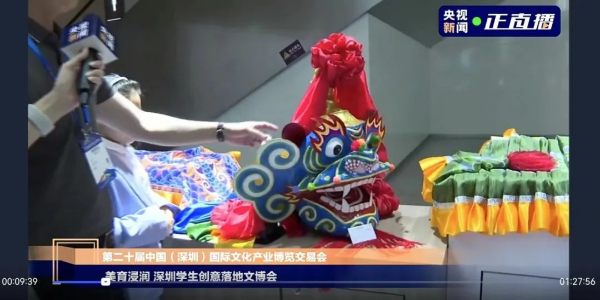The 20th China (Shenzhen) International Cultural Industries Fair (hereinafter referred to as the “Cultural Industries Fair”) was held at the Shenzhen World Exhibition & Convention Center (Bao’an) from May 23 to 27. For the first time, innovative and creative works by elementary and middle school students from Shenzhen were featured at the Fair.
Nearly 1,000 design works created by students from more than 100 schools across Shenzhen were put on display at Booth 16A01 in Hall No. 16. The children’s imaginative and vibrant creations captivated visitors and were featured in the CCTV livestream on May 25. Among these works was “Kylin”, a piece designed by students from Houmen Middle School in the Shenzhen Shenshan Special Cooperation Zone.

The Kylin Dance, with a history of more than 200 years, was included in the second batch of the National Intangible Heritage list in 2008. It is of great significance for studying the folk dance in southern Guangdong.

The work “Kylin” was created by Houmen Middle School students Huang Yuming, Huang Liubi, Hong Kaiyin, and Chen Liudian, under the guidance of their teachers Wen Shuyan, Huang Xiaojing and Luo Dan. Upon receiving the notice that the Cultural Industries Fair was soliciting submissions, Wen Shuyan recalled a Kylin-themed piece students had previously created in art class and encouraged them to expand on it with imagination and creativity. In the process of creation, the four students conducted online research, visited a Kylin Dance inheritor in Shenshan to gain a deeper insight into its origin and performance styles, and received hands-on guidance from Xie Qiuyu, an inheritor of the Kylin head crafting technique.


After several rounds of discussion and idea exchange, the students introduced creative innovations to the traditional appearance of the Kylin, reflecting how young people in Shenshan today interpret and connect with China’s intangible cultural heritage. Over the course of more than two months, they dedicated their extracurricular time to tasks such as assembling, pasting, painting and fitting. The final result—a set of Kylin Dance performance props used in traditional prayer ceremonies—was proudly presented at the Cultural Industries Fair as a tribute to this cherished heritage.

The artwork, which features a blend of green and red, is brimming with youthful vitality and auspicious omens. It vividly embodies people’s aspiration for fortune, peace, favorable weather, and prosperity.
At first glance, the two kylins look roughly the same. A closer look finds distinct characteristics: one kylin, with its red beards, exudes the fierce energy of a tiger, while the other has a more endearing, innocent look, with back beards implying longevity and good health.
This smaller kylin was crafted using traditional folk techniques, with each step faithfully adhering to time-honored methods. Its exquisite craftsmanship and and refined details showcase remarkable skill. In contrast, the bigger one reflects an innovative interpretation of traditional culture. Preserving the traditional essence, it has been re-invigorated with the addition of ocean blue elements.

Zheng Guiting, a senior member of Huang Yuming’s family, is a seasoned Kylin Dance performer who has trained many apprentices and performed Kylin Dance in different places. Influenced by this family tradition, Huang Yuming developed a strong interest in the intangible cultural heritage of the Kylin Dance. “We never imagined that our creation would be exhibited at the Cultural Industrial Fair, let alone featured on CCTV, on CCTV, giving more people the chance to learn about the Kylin Dance.” Huang Yuming said with excitement. He noted that through creating the Kylin artwork, they gained a deeper understanding of the dance and its associated folk crafts, and experienced the true charm of intangible cultural heritage firsthand. He expressed hope that this traditional art form would continue to be passed down and flourish for generations to come.